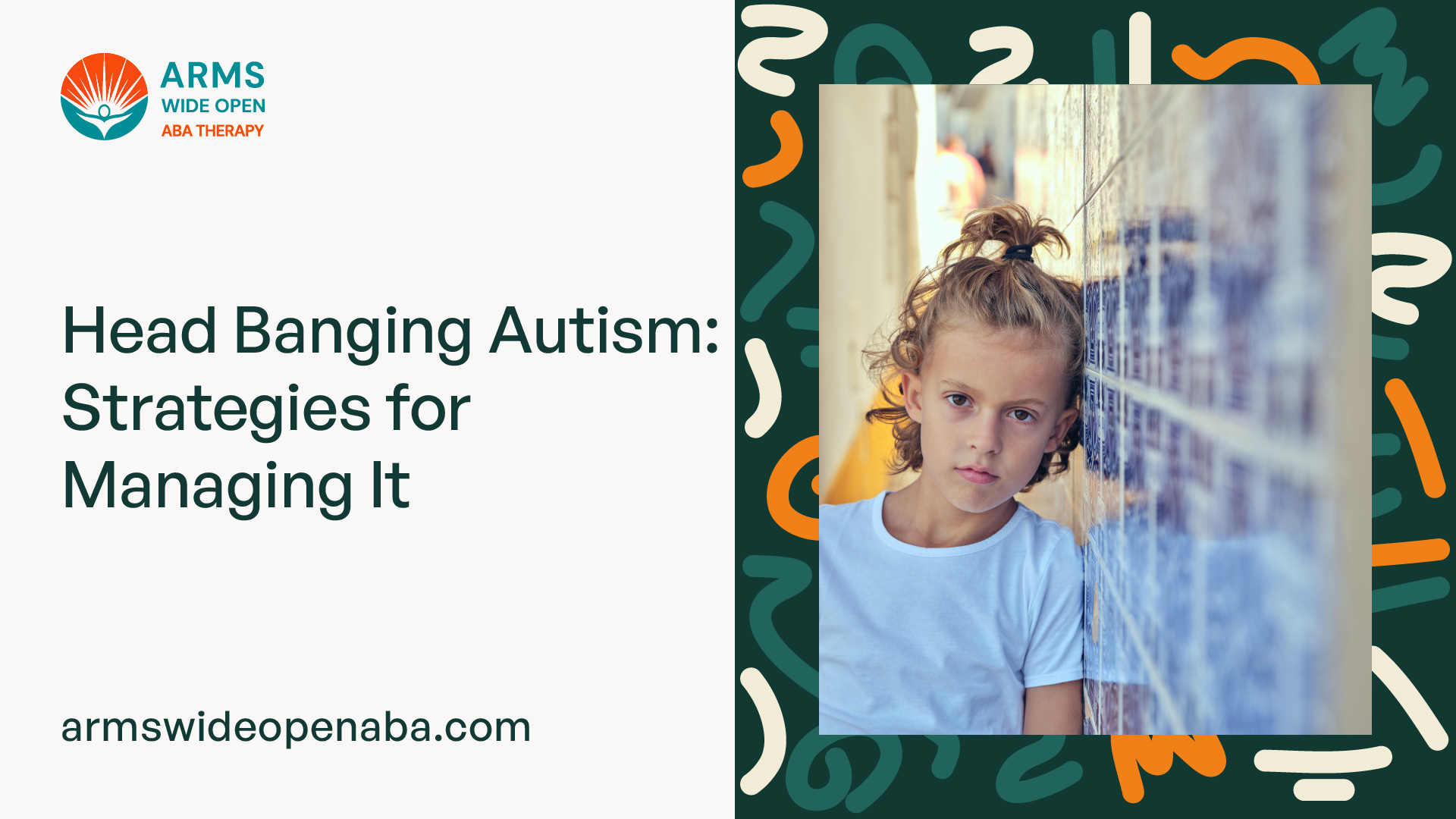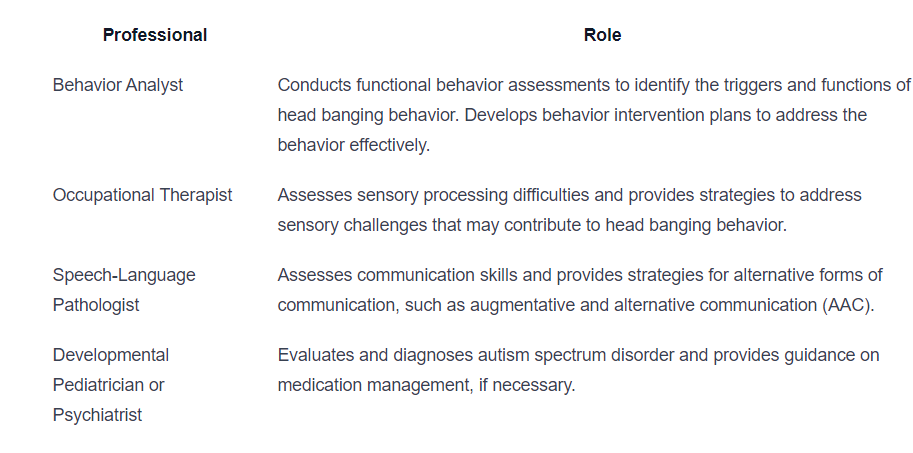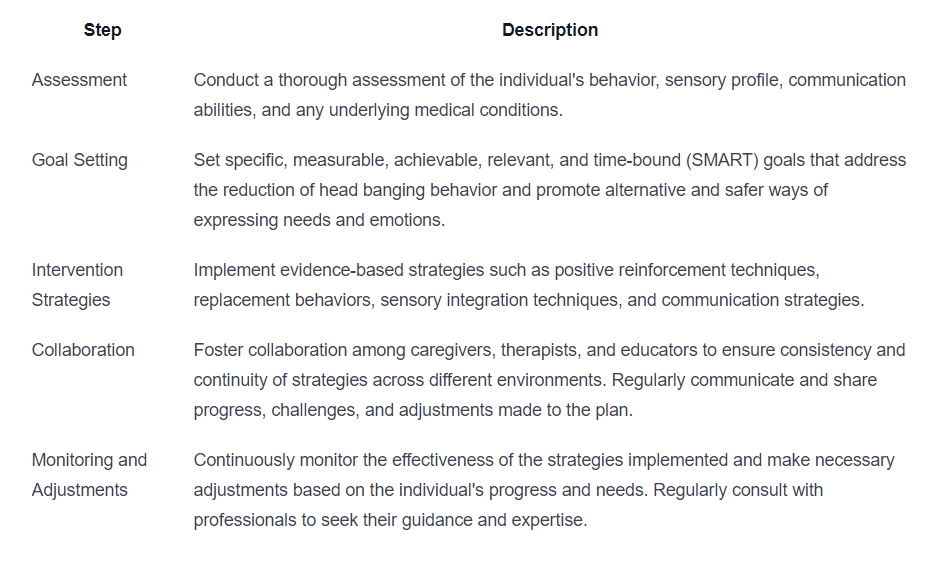Head Banging Autism: Strategies for Managing It
Discover effective strategies for managing head banging in autism. From behavioral techniques to sensory integration, find calm amidst chaos.

Understanding Head Banging in Autism
Head banging is a behavior commonly observed in individuals with autism, and it is essential to understand its nature and underlying reasons in order to effectively manage it.
What is Head Banging?
Head banging refers to the repetitive act of an individual hitting their head against a surface, such as a wall, floor, or furniture. This behavior can range from mild to severe and may occur with varying frequencies and intensities.

Head banging can be distressing to witness, but it's important to note that it is not typically a self-harming behavior. Individuals with autism engage in head banging for various reasons, and it is crucial to explore these underlying factors to address it effectively.
Why Do Individuals with Autism Engage in Head Banging?
There are several potential reasons why individuals with autism may engage in head banging:
- Communication and Expression: For individuals who struggle with verbal communication, head banging may serve as a way to express frustration, discomfort, or a need for attention. It may be a form of communication when other means of expression are limited.
- Sensory Stimulation: Some individuals with autism may engage in head banging to seek sensory input or stimulation. The repetitive impact against a surface can provide a particular sensation that may be soothing or satisfying for them.
- Anxiety and Overwhelm: Head banging can also be a response to anxiety, stress, or sensory overload. The rhythmic movement and pressure against the head may help individuals self-regulate or provide temporary relief from overwhelming emotions or sensory experiences.
- Routine and Predictability: Certain individuals with autism may engage in head banging as a way to establish a sense of routine or predictability. The repetitive nature of the behavior can provide a comforting pattern in their daily lives.
It's important to remember that the reasons behind head banging can vary from person to person. Understanding the specific triggers and functions of the behavior for each individual is crucial for developing effective strategies to manage and support them. By addressing the underlying causes and providing alternative strategies for communication, sensory stimulation, and emotional regulation, it is possible to help individuals with autism reduce or redirect this behavior towards healthier alternatives.
Importance of Managing Head Banging
Understanding the importance of managing head banging in individuals with autism is crucial for their overall well-being and safety. This section highlights the risks and concerns associated with head banging and emphasizes the need for effective strategies to address this challenging behavior.
Risks and Concerns Associated with Head Banging
Head banging can pose various risks and concerns for individuals with autism. These include:
- Physical Injury: Head banging can lead to self-inflicted injuries, such as bruises, cuts, and concussions. The repetitive impact on the head can cause short-term pain and discomfort, as well as long-term physical harm.
- Dental and Facial Trauma: The forceful impact of head banging can result in dental and facial injuries, including chipped teeth, broken jaws, or damage to the soft tissues in the face.
- Concussions and Brain Injury: Severe head banging episodes can potentially cause concussions or even more serious brain injuries. The brain, being a delicate organ, is vulnerable to damage from repeated trauma.
- Social Isolation: Head banging can be distressing for both the individual engaging in the behavior and those around them. It can lead to social isolation, as others may find the behavior challenging to understand or cope with.
- Interference with Daily Activities: Head banging can disrupt daily activities, such as learning, communication, and engagement in social interactions. It can affect the individual's ability to focus and participate in various settings, including school, therapy sessions, and family outings.
The Need for Effective Strategies
Given the risks and concerns associated with head banging, it is essential to develop and implement effective strategies to manage this behavior. These strategies should aim to:
- Ensure Safety: The primary goal of managing head banging is to ensure the safety and well-being of the individual. Strategies should focus on minimizing the risk of physical harm and providing a safe environment.
- Address Underlying Causes: Identifying and addressing the underlying causes of head banging is crucial. This can involve understanding sensory triggers, communication difficulties, or emotional distress that may contribute to the behavior.
- Promote Alternative Coping Skills: Effective strategies should focus on teaching alternative coping skills to the individual. This may involve providing sensory alternatives, teaching communication techniques, or introducing relaxation and self-regulation strategies.
- Collaborate with Professionals: Working with therapists, specialists, and educators is vital in developing a comprehensive management plan for head banging. These professionals can provide guidance, support, and evidence-based interventions tailored to the individual's specific needs.
By recognizing the risks and concerns associated with head banging in autism and acknowledging the need for effective strategies, individuals with autism can receive the support and intervention necessary to manage this challenging behavior. Through a collaborative and holistic approach, it is possible to minimize the risks, address underlying causes, and promote healthier coping mechanisms for a better quality of life.
Behavioral Strategies
When it comes to managing head banging in individuals with autism, behavioral strategies play a crucial role in reducing and redirecting this challenging behavior. By implementing positive reinforcement techniques and teaching replacement behaviors, caregivers and professionals can help individuals with autism find alternative ways to cope with their emotions and needs.
Positive Reinforcement Techniques
Positive reinforcement techniques involve providing rewards or incentives to encourage desired behaviors and discourage head banging. By focusing on reinforcing positive behaviors, individuals with autism can learn to associate these behaviors with pleasant outcomes, increasing the likelihood of repetition.
One effective positive reinforcement technique is the use of visual schedules or token systems. These systems involve breaking down tasks or activities into smaller, manageable steps and providing a visual representation of progress. As the individual successfully completes each step without engaging in head banging, they earn tokens or rewards, reinforcing their positive behavior.
Another approach is the use of social praise and encouragement. Verbal and non-verbal praise, such as saying "Great job!" or giving a high-five, can be powerful motivators for individuals with autism. By acknowledging their efforts and progress in managing their emotions without head banging, caregivers and professionals can reinforce positive behavior and build self-esteem.
Replacement Behaviors
Teaching individuals with autism alternative behaviors to replace head banging is essential for redirecting their actions in a more appropriate and safe manner. These replacement behaviors serve as healthier ways for individuals to communicate their needs and cope with their emotions.
One commonly used replacement behavior is the use of communication tools, such as picture cards or communication apps. These augmentative and alternative communication (AAC) methods provide individuals with a means to express their needs and emotions without resorting to head banging. By teaching and encouraging the use of these communication tools, caregivers and professionals can empower individuals with autism to effectively communicate their desires and frustrations.
Additionally, sensory-based replacement behaviors can be effective for managing head banging. Providing individuals with alternative sensory activities or tools, such as stress balls, fidget toys, or sensory bins, can help redirect their sensory-seeking behaviors away from head banging. These sensory alternatives offer individuals with autism alternative ways to regulate and fulfill their sensory needs.
By implementing positive reinforcement techniques and teaching replacement behaviors, caregivers and professionals can support individuals with autism in managing head banging. It's important to remember that each individual is unique, and strategies should be tailored to their specific needs and abilities. Consistency, patience, and collaboration with professionals can play a significant role in helping individuals with autism find calm and healthier ways to express themselves.
Sensory Strategies
When it comes to managing head banging in individuals with autism, employing sensory strategies can be highly beneficial. These strategies aim to address the sensory needs and sensitivities that may contribute to the behavior. In this section, we will explore two key sensory strategies: sensory integration techniques and providing sensory alternatives.
Sensory Integration Techniques
Sensory integration techniques involve creating a structured and sensory-friendly environment to help individuals with autism regulate their sensory experiences. By providing appropriate sensory input, these techniques can help reduce the likelihood of head banging episodes.
One effective sensory integration technique is deep pressure input. This can be achieved through activities such as deep pressure massages, weighted blankets, or body wraps. The deep pressure provides a calming and grounding effect, helping to alleviate sensory overload and promote relaxation.
Another technique is the use of sensory tools and equipment. These may include fidget toys, sensory balls, or chewable items. These tools can serve as a healthy outlet for sensory-seeking behaviors, redirecting the urge to engage in head banging.
Sensory Integration Techniques
Deep pressure input
Use of sensory tools and equipment
Providing Sensory Alternatives
In addition to sensory integration techniques, providing sensory alternatives can help individuals with autism redirect their sensory needs in more appropriate ways. These alternatives offer sensory experiences that are less harmful and disruptive compared to head banging.
One effective sensory alternative is offering a variety of sensory activities. This may include engaging in tactile play with sensory bins filled with materials like sand, rice, or water beads. Providing opportunities for swinging, bouncing on exercise balls, or engaging in other forms of rhythmic movement can also help fulfill sensory needs in a safe and controlled manner.
It is important to note that sensory alternatives should be tailored to the individual's specific sensory preferences and sensitivities. What works for one person may not work for another, so it may require some trial and error to discover the most effective sensory alternatives for managing head banging.
Providing Sensory Alternatives
Sensory activities
Rhythmic movement
By implementing sensory integration techniques and providing sensory alternatives, it is possible to create an environment that supports individuals with autism in managing their sensory needs and reducing head banging behaviors. However, it is crucial to collaborate with professionals, such as therapists and specialists, to develop a comprehensive management plan that addresses the unique needs of each individual.
Communication Strategies
When it comes to managing head banging in individuals with autism, communication strategies play a vital role in promoting alternative ways to express needs and emotions. By focusing on augmentative and alternative communication (AAC) methods and teaching alternative ways of communication, individuals with autism can better communicate their needs and reduce frustration, potentially decreasing the occurrence of head banging episodes.
Augmentative and Alternative Communication (AAC)
Augmentative and alternative communication (AAC) refers to a range of techniques and tools that help individuals with communication difficulties express themselves effectively. AAC systems can be low-tech or high-tech, depending on the individual's needs and abilities. These systems can include the use of pictures, symbols, sign language, communication boards, or even electronic devices.
By implementing AAC strategies, individuals with autism can communicate their needs, thoughts, and emotions in a non-verbal or partially-verbal manner. This can help reduce frustration and increase their ability to express themselves, potentially decreasing the need for head banging as a means of communication.
Teaching Alternative Ways to Express Needs and Emotions
Teaching alternative ways to express needs and emotions is another important communication strategy for managing head banging in individuals with autism. This involves identifying alternative methods of communication that are more suitable and socially acceptable than head banging.
One approach is to introduce functional communication training (FCT), which focuses on teaching individuals with autism more appropriate ways to communicate their needs and desires. This can involve teaching them simple gestures, sign language, or using visual supports such as picture cards or communication apps on electronic devices. By providing alternative ways to express themselves, individuals with autism can effectively communicate their needs without resorting to head banging.
Another effective strategy is to implement social stories or social scripts. These are personalized stories or scripts that help individuals with autism understand and respond to different situations. By using visual cues and step-by-step instructions, social stories can guide individuals in expressing their needs and emotions in a more socially appropriate manner.
Implementing communication strategies can significantly enhance the ability of individuals with autism to express themselves, reducing frustration and the likelihood of head banging episodes. By utilizing AAC methods and teaching alternative ways of communication, individuals with autism can develop effective communication skills that promote understanding and connection with others.
Collaborating with Professionals
When it comes to managing head banging in individuals with autism, seeking support and collaboration with therapists and specialists is essential. These professionals bring expertise and experience that can help develop a comprehensive management plan tailored to the specific needs of the individual.
Seeking Support from Therapists and Specialists
Therapists and specialists play a critical role in understanding and addressing head banging behaviors in individuals with autism. Here are some professionals who can provide valuable support:

By consulting with these professionals, caregivers and individuals with autism can gain valuable insights and develop a better understanding of the underlying causes of head banging behavior. The professionals can then guide the development and implementation of appropriate and effective strategies.
Creating a Comprehensive Management Plan
To effectively manage head banging in individuals with autism, it is crucial to create a comprehensive management plan. This plan should be tailored to the individual and take into account their unique needs and challenges. Here are key steps to consider when creating a management plan:

A comprehensive management plan provides a structured approach to address head banging behaviors in individuals with autism. By collaborating with professionals, caregivers can access valuable resources, tools, and support to develop and implement effective strategies that promote a safe and supportive environment for individuals with autism.
Sources
https://www.crossrivertherapy.com/autism/head-banging-autism
https://www.abtaba.com/blog/head-banging-autism
https://www.andnextcomesl.com/2019/03/how-to-help-with-head-banging-in-autism.html
Similar articles
We’re here to help you

Our team is here to assist you in this process. Contact us for any assistance.
it’s easy to apply
We Accept Most Insurances
Our in-network insurance partnerships make ABA therapy more accessible to families throughout our service areas.







Our Insurance Process
We'll request your insurance details to help us verify your plan's coverage for ABA therapy. Once we've received this information, we'll walk you through your benefits, including copayments, deductibles and out-of-pocket maximums, so you know what to expect in advance.
Our team will then handle the preauthorization and all the necessary paperwork.
.svg)





















.jpeg)


































.jpeg)




.jpeg)







.jpeg)











.jpeg)
















